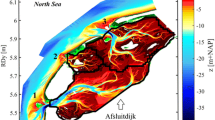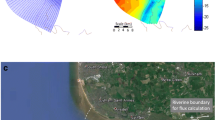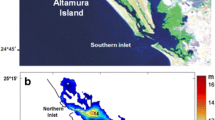Abstract
A two-dimensional, vertically integrated, nonlinear numerical model was applied to investigate the tide-driven bed load transport of sediments and morphodynamics in the shallow coastal lagoon of Yavaros, located in the southeastern part of the Gulf of California, Mexico. Satellite imagery exposes strong sediment dynamics in this coastal region. The dynamics in the lagoon were forced by 13 tidal constituents at the open boundary. Tides are of a mixed character and they are predominantly semidiurnal. The calculations showed areas of intense tidal currents and considerable water exchange with the Gulf of California. Numerical experiments revealed an ebb-dominant tidal distortion and a net export of sediment from the lagoon to the Gulf of California. A simulation of 20 years showed that the lagoon exported about 1,600 m3 of sediment; however, the daily oscillating exchange of sediment reached values of around 8 m3. The daily averaged flux of export–import sediments oscillates principally with semiannual, monthly and fortnightly periods. By applying a threshold velocity, a variable friction coefficient and the calculated amplitude of tidal velocities, it was possible to determine that morphological changes occur in zones of sharp topographic gradients and to explain the effect of friction on the export–import process of sediments. A 10-year simulation revealed that accumulation of sediment (~20 cm) occurred in small areas, whereas erosion occurred in larger areas but with less intensity (~8 cm). Besides the importance for the morphodynamics, these kinds of erosion–accretion processes may be relevant for the marine ecology.









Similar content being viewed by others
References
Ayala-Castañares A, Malpica-Cruz VM, Gutiérrez-Estrada M (1980) Geología marina de la región de Yavaros, Sonora, México. Anales del Centro de Ciencias del Mar y Limnología, UNAM, vol 7, pp 275–290
Baumert H, Radach G (1992) Hysteresis of turbulent kinetic energy in nonrotational tidal flows: a model study. J Geophys Res 97(C3):3669–3677
Carbajal N (1993) Modeling of the circulation in the Gulf of California, Berichte aus dem Zentrum für Klima-und Meeresforschung. Reihe B: Ozeanographie, Nr. 3
Carbajal N, Backhaus JO (1998) Simulation of tides, residual flow and energy budget in the Gulf of California. Oceanol Acta 21:429–446
Carbajal N, Piney S, Gómez-Rivera J (2005) A numerical study on the influence of geometry on the formation of sandbanks. Ocean Dyn 55:559–568
De Vriend HJ (1996) Mathematical modeling of meso-tidal barrier island coasts: Part 1. Empirical and semi-empirical models. In: Liu PL-F (ed) Advances in coastal and ocean engineering, vol 2, pp 115–149
Dronkers J (1986) Tidal asymmetry and estuarine morphology. Neth J Sea Res 20(2/3):117–131
Dronkers J (1998) Morphodynamics of the Dutch Delta. In: Dronkers J, Sheffers M (eds) Physics of estuaries and coastal seas. Balkema, Rotterdam, pp 297–304
Dworak JA, Gómez-Valdés J (2003) Tide-induced residual current in a coastal lagoon of the Gulf of California. Estuar Coast Shelf Sci 57:99–109
Dworak JA, Gómez-Valdés J (2005) Modulation of shallow water tides in an inlet-basin system with a mixed tidal regime. J Geophys Res 110:C01007. doi:10.1029/2003JC001865
Friedrichs CT, Aubrey DG (1988) Non-linear tidal distortion in shallow well-mixed estuaries; a synthesis. Estuar Coast Shelf Sci 27:521–545
Gerlach SA (1978) Food-chain relationships in subtidal silty marine sediments and the role of meiofauna in stimulating bacterial productivity. Aecologia (Berl.) 33:55–69
Gray JS (2002) Species richness of marine soft sediments. Mar Ecol Prog Ser 244:285–297
Hibma A, Stive MJF, Wang ZB (2004) Estuarine morphodynamics. Coast Eng 51:765–778
Julien PY (1998) Erosion and sedimentation. Cambridge University Press, New York
Kjerfve B, Magill KE (1989) Geographic and hydrodynamic characteristics of shallow coastal lagoons. Mar Geol 88:187–194
Lankford RR (1977) Coastal lagoons of Mexico: their origin and classification. In: Wiley M (ed) Estuarine processes. Academic Press, New York, pp 182–215
Marghany M (2013) DInSAR technique for three-dimensional coastal spit simulation from Radarsat-1 fine mode data. Acta Geophys 61(2):478–493
Marghany M, Hashim M, Cracknell AP (2011) Simulation of shoreline change using AIRSAR and POLSAR C-band data. Environ Earth Sci 64:1177–1189
Mason DC, Garg PK (2001) Morphodynamic modelling of intertidal sediment transport in Morecambe Bay. Estuar Coast Shelf Sci 53(1):79–92
Montaño Y, Carbajal N (2008) Numerical experiments on the long term morphodynamics of the Colorado River Delta. Ocean Dyn 58:19–29
Montaño-Ley Y, Peraza-Vizcarra R, Páez-Osuna F (2007) The tidal hydrodynamics modeling of the Topolobampo coastal lagoon system and the implications for pollutant dispersion. Environ Pollut 147(1):282–290
Nichols MM, Boon JD (1994) Sediment transport processes in coastal lagoons. Elsevier oceanography series, coastal lagoon processes. Elsevier, Amsterdam, vol 60, pp 157–219
Páez-Osuna F, Guerrero-Galván SR, Ruiz-Fernández AC (1998) The environmental impact of shrimp aquaculture and the coastal pollution in Mexico. Mar Pollut Bull 36(1):65–75
Ruiz-Fernández AC, Hillaire-Marcel C, Ghaleb B, Páez-Osuna F, Soto-Jiménez M (2001) Isotopic constraints (210Pb, 228Th) on the sedimentary dynamics of contaminated sediments from a subtropical coastal lagoon (NW Mexico). Environ Geol 41:74–89
Soto-Jiménez MF, Páez-Osuna F (2001) Distribution and normalization of heavy metal concentrations in mangrove and lagoonal sediments from Mazatlán Harbor (SE Gulf of California). Estuar Coast Shelf Sci 53:259–274
Speer PE, Aubrey DG (1985) A study of non-linear tidal propagation in shallow inlet/estuarine systems part II: theory. Estuar Coast Shelf Sci 21:207–224
Speer PE, Aubrey DG, Friedrichs CT (1991) Non linear hydrodynamics of shallow tidal inlet/bay systems. In: Parker BB (ed) Tidal hydrodynamics. John Wiley & Sons inc., New York, pp 885
Thomas CG, Spearman JR, Turnbull MJ (2002) Historical morphological change in the Mersey Estuary. Cont Shelf Res 22:1775–1792
Van Rijn LC (1993) Principles of sediment transport in rivers, estuaries and coastal seas. Aqua Publications, Amsterdam
Wunsch C (1967) The long-period tides. Rev Geophys 5(4):447–475
Zenkovich VP (1969) Marine geology, Mexico. UNESCO. Serial No.1281/BMS.RD/SCE, Paris
Author information
Authors and Affiliations
Corresponding author
Rights and permissions
About this article
Cite this article
Carbajal, N., Dworak, J.A., Montaño-Ley, Y. et al. Influence of friction on erosion and accretion processes in the Yavaros Bay, Gulf of California. Environ Earth Sci 72, 429–440 (2014). https://doi.org/10.1007/s12665-013-2963-1
Received:
Accepted:
Published:
Issue Date:
DOI: https://doi.org/10.1007/s12665-013-2963-1




